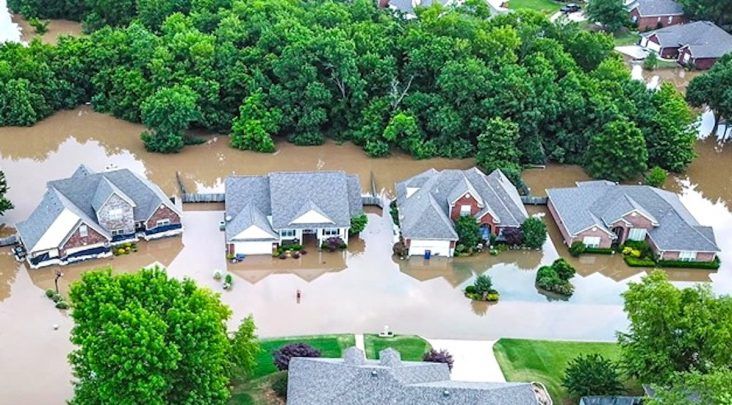Staying safe and documenting damage key when returning to flooded homes
by June 3, 2019 3:50 pm 1,412 views

Flooded homes in Fort Smith. (photo courtesy of Austin Collins)
Now that floodwaters are retreating in the Fort Smith and Van Buren areas affected by the swollen Arkansas River, there are two important things homeowners should remember — stay safe and file a claim.
“We want, we need, everyone to be safe, first and foremost. We can’t stress that enough,” said Jason Hargraves, managing editor at insuraceQuotes.com, which publishes in-depth studies, data and analysis related to auto, home, health, life and business insurance.
When reentering homes, homeowners need to use extreme caution, said Arkansas Department of Emergency Management Spokeswoman Melody Daniels.
“If electricity is on in your home, please be careful. Most outlets are, what, 18 inches or so from the floor? That can be very dangerous if there is or has been water in the house,” Daniels said.
Once homeowners can safely make it into their homes, they need to do all they can to keep more damage from occurring, then need to assess and start the paperwork, Hargraves said.
“Go to your agent, even if you don’t have flood insurance, and start a claim,” he said. “When it comes to floods, it’s a first come, first served basis. Do not wait.”
According to the Federal Emergency Management Agency (FEMA), after experiencing a flood, homeowners should contact their agent or insurance company to start a claim and consider requesting an advance payment in order to start the recovery process as soon as possible. Regular homeowners insurance will not cover flooding from a disaster such as this, Hargraves said.
“If it comes from above, like a tornado tears of the roof and rain pours in or a hot water tank bursts, it’s covered. If it comes from below, from a river flooding or something of that nature, it’s flooding and not covered,” he said.
The average cost of flood insurance nationwide is $600 a year. That number is skewed because, for those in a flood plain, the cost runs from $1,000 to $2,000 a year, he said. In the United States, 20% of homeowners have flood insurance, he added.
“Obviously that is skewed because if you live in the mountains, you wouldn’t. So more people in areas it might flood do have it,” Hargraves said.
Something important for homeowners to know, Hargraves said, is the federal maximum payout with federal home flooding insurance is $250,000 for a house and $100,000 for belongings.
“That means for some with very expensive homes, if the damage is over $250,000 to the structure, it’s on the homeowner,” he said.
Also, basements are mostly not covered. The only thing covered in basement flooding is structural, such as beams and studs, Hargraves said.
“So if you have a finished basement with carpet and drywall and a television, that is all basically on you,” he said.
But homeowners without flood insurance are not without help. FEMA can help with grants, low-interest loans and in some instances temporary housing until their homes are habitable again, Hargraves said. In order to qualify for federal assistance, homeowners will need a letter from their insurance carrier saying a claim for flood damage has been denied, said Phil Hicks with Shelter Insurance.
“They have to have something in writing, a letter of denial,” Hicks said.
Morrison-Shipley issued a statement about the unprecedented flooding and noted that many homeowners affected by the flooding do not have flood insurance because they were not in a mapped flood zone.
“We have been involved with FEMA flood studies for many years, and the extent of the devastation is honestly something we thought we would never see. We know that many of those affected did not have flood insurance because their property was not deemed to be in a mapped flood zone,” the statement said. “Homeowners who lost property need to file a claim with their insurer regardless of whether or not they carried flood insurance. Once the claim is denied by a private insurance carrier, the claim denial letter can be forwarded to FEMA with the hope that some of the damages will be covered.”
Photos are important. Even if homeowners do not have photos of their home and belongings prior to the flooding, they need to take photos of everything to show all damage when they return to their home, Hargraves said. A detailed assessment of damage can also be very helpful, he said.
But homeowners don’t need to worry too much about knowing exactly how high the water was in their house and what exactly it damaged, Daniels said.
“The experts and adjusters are very good at determining that. They will know what happened and will be able to help homeowners,” she said.
Morrison-Shipley said the firm’s UAV mapping team collected high-resolution aerial data to document the flood limits and approximate ground surface elevations.
“We are in the process of compiling these, and we will make these available at NO CHARGE to anyone who needs them,” the firm’s release said, noting they also will release information on how to obtain that once it is available.
